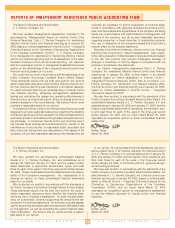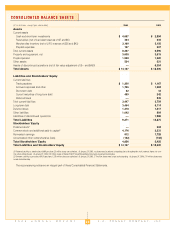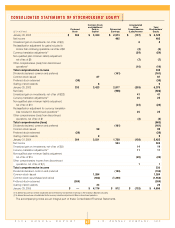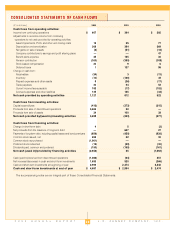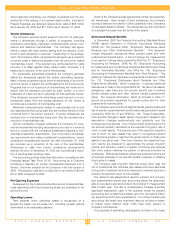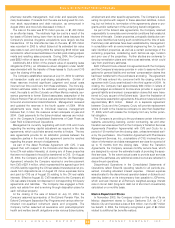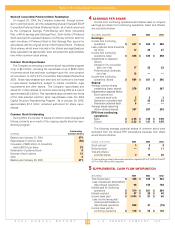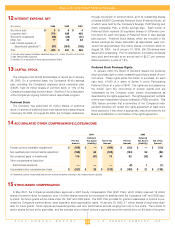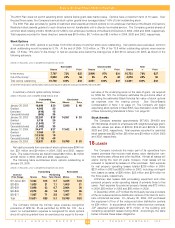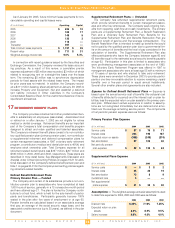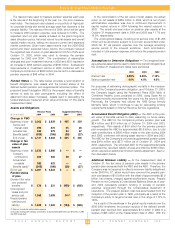JCPenney 2004 Annual Report Download - page 34
Download and view the complete annual report
Please find page 34 of the 2004 JCPenney annual report below. You can navigate through the pages in the report by either clicking on the pages listed below, or by using the keyword search tool below to find specific information within the annual report.
J.C. PENNEY COMPANY, INC.2 004 ANNUAL REPORT
Notes to the Consolidated Financial Statements
32
Cash and Short-Term Investments
All highly-liquid investments with original maturities of three
months or less are considered to be short-term investments. The
short-term investments consist primarily of eurodollar time deposits
and money market funds and are stated at cost, which approxi-
mates fair market value.
Total Cash and Short-Term Investments were $4,687 million and
$2,994 million for 2004 and 2003, respectively, and included
restricted short-term investment balances of $63 million and $87
million for the same periods. Restricted balances are pledged as
collateral for import letters of credit not included in the bank credit
facility and/or for a portion of casualty insurance program liabilities.
Cash and Short-Term Investments on the Consolidated Balance
Sheets included $46 million and $8 million of cash for 2004 and
2003, respectively.
Receivables, Net
Net Renner credit card receivables were $125 million and $89
million as of year-end 2004 and 2003, respectively. The corre-
sponding allowance for bad debts was $7 million and $5 million at
the end of 2004 and 2003, respectively. Also included in this clas-
sification are notes and miscellaneous receivables, including a
$163 million current deferred tax asset at year-end 2004.
Merchandise Inventories
Inventories are valued primarily at the lower of cost (using the last-
in, first-out or “LIFO” method) or market, determined by the retail
method for department stores and store distribution centers, and
standard cost, representing average vendor cost, for
Catalog/Internet and regional warehouses. The lower of cost or mar-
ket is determined on an aggregate basis for similar types of mer-
chandise. To estimate the effects of inflation/deflation on ending
inventory, an internal index measuring price changes from the begin-
ning to the end of the year is calculated using merchandise cost data
at the item level.
Total Company LIFO (credits)/charges included in Cost of Goods
Sold were $(18) million, $(6) million and $6 million in 2004, 2003 and
2002, respectively. If the first-in, first-out or “FIFO” method of inven-
tory valuation had been used instead of the LIFO method, invento-
ries would have been $25 million and $43 million higher at January
29, 2005 and January 31, 2004, respectively.
Property and Equipment, Net
Estimated
Useful Lives
($ in millions)
(Years) 2004 2003
Land
— $ 203 $ 206
Buildings
50 2,693 2,554
Furniture and equipment
3-20 2,145 2,203
Leasehold improvements
674 674
Accumulated depreciation (
2,077) (2,122)
Property and equipment, net
$ 3,638 $ 3,515
Property and equipment is stated at cost less accumulated
depreciation. Depreciation is computed primarily by using the
straight-line method over the estimated useful lives of the related
assets. Leasehold improvements are depreciated over the shorter
of the estimated useful lives of the improvements or the term of the
lease, including renewals determined to be reasonably assured.
Routine maintenance and repairs are expensed when incurred.
Major replacements and improvements are capitalized. The cost
of assets sold or retired and the related accumulated depreciation
or amortization are removed from the accounts with any resulting
gain or loss included in net income/(loss).
Capitalized Software Costs
Costs associated with the acquisition or development of software
for internal use are capitalized and amortized over the expected
useful life of the software, generally between three and seven
years. Subsequent additions, modifications or upgrades to inter-
nal-use software are capitalized only to the extent that they allow
the software to perform a task it previously did not perform.
Software maintenance and training costs are expensed in the peri-
od incurred.
Goodwill
Management evaluates the recoverability of goodwill annually and
whenever events or changes in circumstances indicate that the car-
rying value may not be recoverable. During 2004, management per-
formed the annual evaluation of goodwill as it relates to the
Company’s investment in its Renner Department Stores in Brazil.
The fair value of the Company’s Renner Department Store operation
was determined using the expected present value of corresponding
future cash flows, discounted at a risk-adjusted rate. Management
concluded that there was no evidence of impairment as of year-end
2004.
The 2004 change in the carrying amount of goodwill, included in
Other Assets, was as follows:
($ in millions)
Goodwill
Balance as of January 31, 2004
$42
Foreign currency translation adjustment
1
Balance as of January 29, 2005
$ 43
At year-end 2003, management had been authorized by the Board
of Directors to sell Eckerd and was engaged in active negotiations
with interested parties. The “more-likely-than-not” expectation that
Eckerd would be sold was a triggering event for possible goodwill
impairment, and a goodwill impairment review was performed at the
Eckerd reporting level. While no impairment was identified based on
the results of the two-step impairment test prescribed by SFAS No.
142, “Goodwill and Other Intangible Assets,” adjustments were
made at the end of 2003 to reduce the Company’s investment in
Eckerd to its fair value less costs to sell and to reflect the estimated
tax impact of a potential sale. See Note 2 for discussion of the
Eckerd disposition.
Impairment of Long-Lived Assets
In accordance with SFAS No. 144, “Accounting for the
Impairment or Disposal of Long-Lived Assets,” the Company eval-
uates long-lived assets for impairment whenever events or
changes in circumstances indicate that the carrying amount of
those assets may not be recoverable. Factors considered impor-
tant that could trigger an impairment review include, but are not
limited to, significant underperformance relative to historical or pro-
jected future operating results and significant changes in the man-
ner of use of the assets or the Company’s overall business strate-
gies. For long-lived assets held for use, SFAS No. 144 requires that
if the sum of the future cash flows expected to result from the use
and eventual disposition of a company’s long-lived assets, undis-
counted and without interest charges, is less than the reported
value of those assets, an evaluation must be performed to deter-
mine if an impairment loss has been incurred. The amount of any




